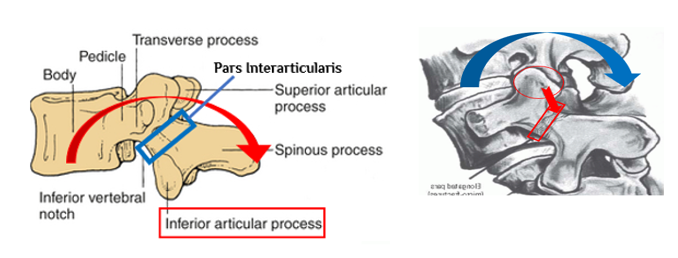Blog
What Is Spondylolysis?
Affecting around 6% of the population, spondylolysis is a stress fracture at the pars interarticularis.
What is pars interarticularis?
Image from The Tennis PhysioThe picture above shows the site of stress fracture pars interarticularis. This is a segment of bone that connects the facet joints at the back of the spine.
Cause of stress fracture
A stress fracture occurs as a result of repetitive loading and stress. In the lumbar spine, spondylolysis most commonly occurs at the level of L5 due to repetitive hyperextension and rotation of the back (bending backwards).
Spondylolysis is a common cause of back pain in young athletes as they have increased risks of having stress fracture at their pars interarticular is due to repetitive movements. This population may include gymnasts, cricketers and wrestlers.
Some may also have higher risks due to genetics as they may have lower cortical bone density than others.
Click here to find out more about spondylolysis.
Symptoms
In many cases, people with spondylolysis do not have obvious symptoms. However, when symptoms occur, they can include:
- Low back pain with possible radiating pain into the buttock or thigh
- Increased symptoms with movements
- Symptoms improve with rest
- Some people may also have difficulty with walking or standing
Diagnosis and physical examination
The Gold Standard for diagnosing spondylolysis is from a SPECT computer tomography (CT) scan.
Physiotherapists and/or doctors will also perform physical examination to rule out other possible causes of low back pain, including tumors, malignancies.
Treatment
Physiotherapists are trained to help patients with spondylolysis by reducing pain and swelling, providing advice and education and teaching exercises to help strengthen/maintain flexibility of the muscles of your back/lower limbs.
Depending on the stage of rehabilitation you are in, treatment may differ. You may expect a few stages of the rehabilitation process:
- Pain and inflammatory reduction: by avoiding rotational and extension movements. Your physiotherapist may ask you to cease your sporting activity temporarily to allow relative rest, thus reducing your symptoms.
- Strength and maintenance of flexibility: Strengthening exercises of the muscles around your spine and your hamstrings may be important for your recovery.
- Restoration of functional movement: Your physiotherapist may give you exercise programs to help you return to sport once your symptoms have settled. Movements with good control is the main goal from this stage of the rehabilitation process.
References
Lumbar Spine Stress Fractures — Spondyolysis – The Tennis Physio – Medium. (2018). Retrieved from https://physioclinician.medium.com/the-sporting-lumbar-spondylolysis-75ed41ed27e
Lumbar Spondylolysis Video. (2018). Retrieved from https://www.spine-health.com/video/lumbar-spondylolysis-video
Spondylolysis. (2018). Retrieved from https://www.physio-pedia.com/Spondylolysis#cite_note-Elien_1-1
Spondylolysis and Spondylolisthesis – OrthoInfo – AAOS. (2018). Retrieved from https://orthoinfo.aaos.org/en/diseases–conditions/spondylolysis-and-spondylolisthesis/
Spondylolysis in Young Athletes. (2018). Retrieved from https://www.physio-pedia.com/Spondylolysis_in_Young_Athletes

